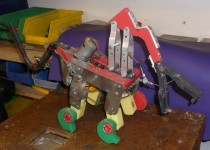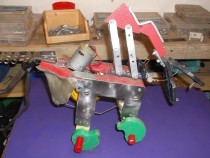Upgrading the ‘baby’ : first step, making claws with a slip-clutch
The ‘baby’ one was originally made with quite wide legs/claws made using ‘Polymorph’ (nylon-like material that can be shaped by hand when heated) …
These looked quite effective but it was found that a cam type shape is better and puts less strain on the motor and gearbox as the loading is more gradual.
The above Polymorph claws were quite wide, hence the wide red spindles shown below.
I decided to replace these with simple flat plastic cam-type claws as shown above (in line with the other versions) and incorporating a simple slip-clutch mechanism so as to avoid damaging the motor gearboxes.
The image above shows the claw which as it is allowed to slip, needs to be retained on the spindle. This has been done with a split-pin (cotter pin).
The image below shows the simple clip-clutch, achieved by cutting a slot and adding a screw to pinch the claw on the red shaft.
The modified prototype is shown below.
The next task is to rework the drive mechanism, that is, to change the worm and wheel for a crank mechanism (again, with a slip-clutch).







